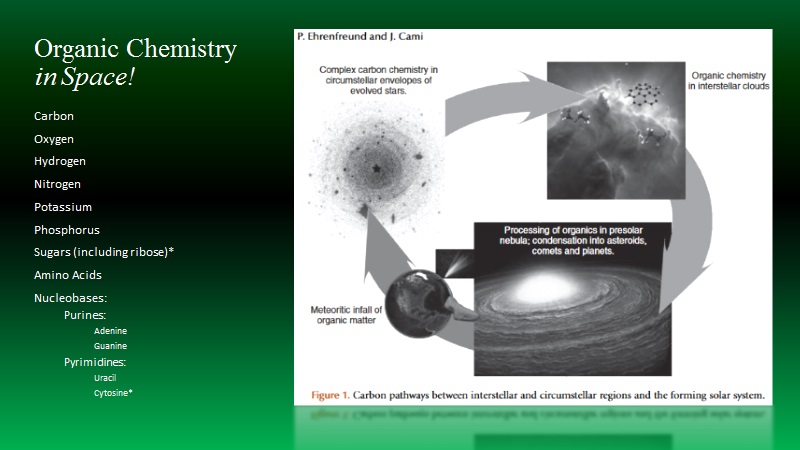Panspermia
Life from Space
Introduction
Panspermia is the transference of biological material from one habitat to another across the near-vacuum of space. Typically this means the colonization of one planet by lifeforms from another, and is most often used in reference to the hypothesis that life may have arrived on the early Earth from the nearby planet Mars.
Scale of Panspermia
 |
Interplanetary Panspermia — the transplantation of life from one planet to another within the same planetary system. |
|
Interstellar Panspermia — the transplantation of life from one planetary system to another. This would also necessarily be a form of interplanetary panspermia. |
Nature of Panspermia
|
Lithopanspermia — refers to the transference of material via rocks, such as bacteria ending up in space-borne ejecta after a meteoritic impact. |
|
 |
Chemopanspermia — or “molecular panspermia”, refers to the transference not of full-fledged lifeforms, but to their basic molecular components. There is a great deal of evidence in favor of molecular panspermia. |
Evidence for Panspermia?
 |
Extremophiles & Extremotolerant Organisms — provide ample evidence that it is at least possible for organisms to survive long trips through space. |
|
Meteorites — left over from the early Solar system contain many of the organic compounds necessary for life, bolstering the case for chemolithopanspermia to a level of certainty at which almost all argument centers around degree; that is how much of the necessary prebiotic chemistry happened in space before the Earth was formed? |
|
|
Organic Astrochemicals — found in the interstellar medium include some complex compounds such as isopropyl cyanide (cite?), and even nucleobases like adenine (cite?). |
Scenarios
|
Mars-Earth Interplanetary Lithopanspermia — has been suggested as the possible origin for life on Earth. According to this idea, Mars had the conditions necessary to generate and/or foster life before Earth did, and that we Earthlings are in fact originally Martians. Life may have begun on Mars, or else Mars was merely colonized first before infecting Earth in turn. |
|
 |
Mother Earth & Father Mars — is a scenario in which the archaea are native to planet Earth, whereas the bacteria are from somewhere further away, such as Mars. Since it is academic at this point that all life on Earth shares a common genetic ancestor, this would necessarily have to be a prebiotic LUCA model, in which the last common ancestor of the archaea and the bacteria was not yet a “true” lifeform, and that the archaea and bacteria evolved traits of “true” life later on in an example of convergent evolution. The genetic common ancestor of these two groups would therefore logically have originally inhabited an environment unlike Earth or Mars. |
|
Galactic Microbiota — considering the frequency with which the Earth is hit by meteors, the amount of impact ejecta kicked up with each meteor strike, the amount of space dust that lands on the Earth every year, and the number of microbial colony-forming units (CFUs) that could indwell even micron-sized grains, microbe-containing impact ejecta from Earth may be subsequently pulverized by collisions into micron-sized particles that, though large enough to contain colonies of microbial life and shield them from UV radiation, would be small enough to be carried out to the Kuiper Belt via Solar winds eventually to be deposited in the protoplanetary discs of future planetary systems as the Solar system moves through interstellar dust clouds in its course through the Milky Way (Wallis, 2003; Napier, 2003), seeding the Milky Way in just a few billion years, which, considering any Earth-like planet could hypothetically have done the same, makes it highly unlikely that Earth Herself was not a beneficiary of such a process (Napier, 2003), which in-turn means that no matter where we find extrasolar life anywhere in the galaxy, no matter how far away, even if it's on the opposite side of the galaxy, it will almost inevitably turn out to be related to us. So it is entirely possible that the archaea and bacteria here on Earth are but two examples of a larger, galaxy-spanning prokaryotic microbiota. |
References
Napier, W. M. A mechanism for interstellar panspermia. Mon. Not. R. Astron. Soc. 348, 52-61 (2004). Accepted 2003 October 2. Recieved 2003 October 1; in original form 2003 April 4. doi:10.1111/j.1365-2966.2004.07287.x
http://onlinelibrary.wiley.com/doi/10.1111/j.1365-2966.2004.07287.x/abstract
Wallis, Max K. and Wickramasinghe, N. C. Interstellar transfer of planetary microbiota. Mon. Not. R. Astron. Soc. 348, 52-61 (2004). Accepted 2003 October 23. Recieved 2003 October 23; in original form 2003 June 5. doi:10.1111/j.1365-292004.07355.x
https://www.researchgate.net/publication/227621140_Interstellar_transfer_of_planetary_microbiota

